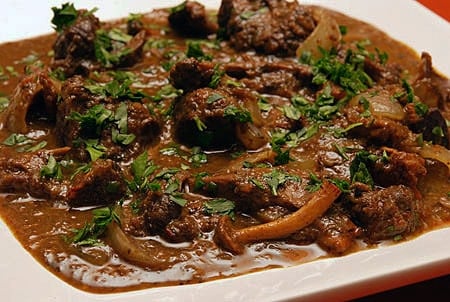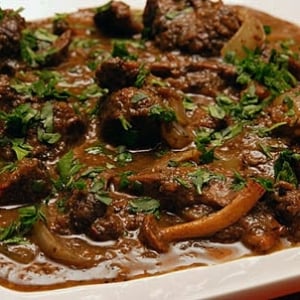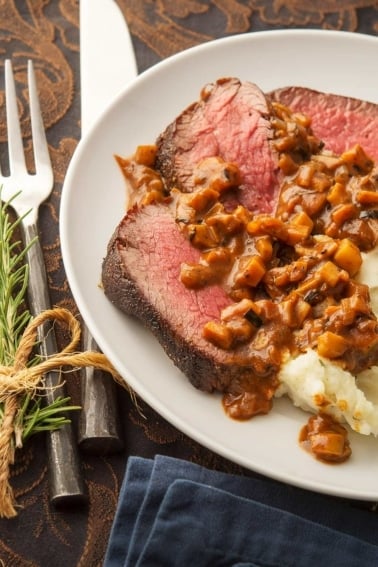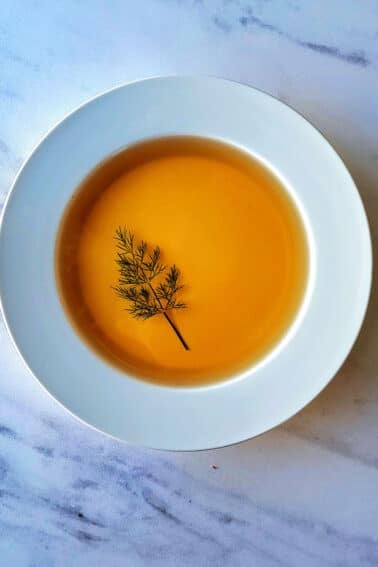As an Amazon Associate I earn from qualifying purchases.

This post could be subtitled, “Why the French aren’t all bad.” But then I could also fall back on the fact that this recipe is equally well-known in Britain, where it is known as Jugged Hare. Civet de Lievre sounds so much better, though…
Pause for a moment and think about this recipe. Jugged hare, civet of hare, whatever you call it, this is a recipe George Washington would have known and probably ate. Hell, John Smith would have been able to eat an early version of jugged hare back in Jamestown a century before Washington — if he had access to some good wine.
Flash forward four centuries, and access to good wine is no longer an issue: Access to a hare is. Isn’t a hare a rabbit? Not in the least. Hares, mostly known as jackrabbits in the United States, live longer, run faster, are smarter and are generally tougher to eat — and to catch. Hares have red meat like beef, not white meat, like rabbits or chickens.
Can you buy a hare? Yes, but there is only one place I know of: D’Artagnan meats. But buying a wild Scottish hare will cost you more than $60. That’s about $15 per person, as a hare typically feeds four. I prefer to shoot jackrabbits, when I can find them. There is no season on them in California, so they are fair game all year long.
Scared off yet? I hope not, because civet of hare is a truly special dish. It is one of those recipes that hearkens back to the days of Brillat-Savarin, or Antonin Careme or Escoffier. This is the real deal, folks, and it ain’t easy to make. But it’s worth it.
Look at this lovely dish: Perfectly braised hare, tender, deeply flavored and meaty. It is accompanied by fresh chanterelle mushrooms, which are one of princes of the mycological realm. But the real hero of this dish is the sauce. Silky, rich, with a depth of flavor that makes you shut up and think about what you just put in your mouth — Oh yes, folks, civet of hare is definitely worth it.
My chief inspiration for my own version of jugged hare is Paula Wolfert’s The Cooking of Southwest France, and if you are a duck hunter (or just a lover of duck and goose) you really need this book. It has whole sections on what to do with every part of the bird, and has proved to be an invaluable resource in my own explorations of eating everything but the quack.
I made this dish last weekend with a jackrabbit I had frozen back in September. I get so few hares every year that I always feel the need to do something special with them. So I began my civet on Friday.
You need to marinate the hare in wine and brandy (with the alcohol burned off) for at least a day. Then you brown the hare and the vegetables from the marinade, then clarify the marinade itself.
The dish then needs nearly three hours of gentle heat to turn a tough old hare into a meltingly tender meal. And then there’s the sauce, which must be pushed through a food mill or otherwise blended. Don’t have a food mill? Buy one. I use mine almost every week. But you’re not done yet.
There is something different about a civet, or a jugged dish. Hares, by the by, aren’t the only animals “jugged.” Venison, ducks, geese, etc all appear cooked in this fashion. What they all have in common is that the sauce is thickened with the blood and liver of the animal, pureed with heavy cream. Pretty scary, eh? I thought so.
If you are a hunter, you will want to save some blood from the hare in a small container, mixed with a little red wine vinegar to preserve it. If not, you can either wrangle some pork blood from an Asian market or just skip it altogether. Blood is good to have, but not as critical as the liver.
Definitely keep the hare’s liver if you hunted it, although you will need to watch for sick livers — they will be striated, or have white specks in them or will look otherwise “not right.” And be sure to wear gloves when butchering rabbits and hares in California; there is a disease called tularemia that one in a million rabbits will be carrying. I have never seen it, but better safe than sorry.
Even safer would be to use a duck’s liver, or if you are not a hunter, a chicken liver or two. Buzz it in a food processor with the heavy cream and marvel at how disturbingly similar it looks to Strawberry Quik. Ew. No matter, this mixture gets stirred into your finished sauce to thicken it.
Why all this bother? Because back in the 17th and 18th centuries, adding blood and pureed livers was an accepted way to thicken a sauce and add flavor at the same time. Can you make an arrowroot or corn starch slurry and thicken your civet? Yes, but then it wouldn’t really be the same, now would it?
It is all a lot of work. But what’s important about all this is not so much that you attempt to make an authentic civet of hare. What isimportant is to respect the techniques and ideas the founders of haute cuisine developed centuries ago. Even if you only do it occasionally, there is something deeply satisfying about taking the time to do things the Old Way, to go through the effort of straining, and clarifying and braising, and so on — you may be surprised at how much those old Frenchmen knew.
Civet of Hare
Ingredients
- 1 hare or 3 cottontail rabbits, or 2 domestic rabbits
- Blood from the critters, mixed with a little red wine vinegar (optional)
- 2 carrots, grated
- 2 celery sticks, minced
- 1 large onion, grated
- 3 bay leaves
- 1 tablespoon dried thyme
- 1 tablespoon chopped fresh rosemary
- 1/4 cup brandy
- 1 bottle red wine
- flour for dusting
- 1/4 pound bacon
- 5 tablespoons duck fat or butter
- 1/2 ounce dried mushrooms
- 1 tablespoon sugar
- 1 teaspoon quatre epices
- 1 pint stock or broth (any kind)
- 1/4 pound fresh mushrooms
- 1 onion, sliced
- 1 tablespoon heavy cream
- 1 tablespoons minced parsley
- Salt and black pepper
Instructions
MARINADE
- Pour the brandy and the wine into a pot and bring to a boil. Let it boil for a few minutes to burn off most of the alcohol. Turn off the heat.
- Cut the hare into large pieces: back legs, front legs, saddle into several sections — feel between vertebrae for places to chop with a cleaver or heavy knife. Salt it lightly.
- While the wine-brandy mixture is still warm, pour it into a container large enough to hold the hares or rabbits. Add the grated onion, carrot and the minced celery, plus the rosemary, bay leaves and thyme. Mix well.
- When the wine mixture is room temperature, add the hare pieces. Cover and let it marinate in the fridge for a day, or even two.
MAKE THE STEW
- Take the hare from the marinade and pat it dry.
- Strain the marinade through a fine-meshed sieve into a bowl. Set aside the veggies.
- Pour the marinade into a pot and bring to a boil. A raft of scum will form on top. Skim it off carefully. Bring the heat to a simmer, and skim the liquid several times until it is clear, then turn off the heat.
- Heat half the goose fat or lard in a large pot or Dutch oven over medium-high heat.
- Dust the pieces of hare in the rye flour — using something other than white flour adds a subtle earthy note to the civet — and brown them in the pot. Take your time with this; you may need to do it in batches. Once the hare is nicely browned, set it aside.
- Meanwhile (you need to multi-task here), heat another tablespoon or two of the goose fat or lard in a large frying pan over medium-high heat. When it is good and hot, turn the heat down to medium-low and add the pancetta. If you are using bacon, only use enough goose fat to lubricate the bottom of the pan, as the bacon should be fatty enough.
- Preheat the oven to 300 degrees.
- Slowly cook the pancetta or bacon until crispy. Remove and set aside.
- Add the veggies to the frying pan you cooked the pancetta in, and turn the heat all the way up. It will sputter. Toss and cook the veggies, adding more goose fat or lard as needed. Once they are coated and much of the liquid has steamed off, turn the heat down to medium and cook until they caramelize, about 10-12 minutes. Stir occasionally.
- Return the hare to the Dutch oven and add the pancetta or bacon. Pour over the wine-brandy mixture, then add the veggies. Add the dried chanterelles, the quatre epices and the sugar. Make sure everything is evenly distributed.
- If you think you need more liquid, add the game, veggie or beef stock. Bring this to a simmer and taste for salt — add some if needed.
- Cover and put in the oven and leave it undisturbed for 2 1/2 to 3 hours for a hare, 90 minutes for rabbits.
MAKING A STEW A CIVET
- Once the hare is tender, almost falling off the bone, carefully remove it from the pot and set aside to cool.
- While the meat is cooling, run everything left in the pot through a food mill with a medium plate. If you don’t have a food mill, run it through a food processor or use an immersion blender. If you are doing this you really should push the blended mix through a sieve or chinois to catch any lumpy bits.
- Clean the Dutch oven, or get another large, lidded pot.
- Pick the meat from the bones of the hare. Try to keep the meat in large pieces and be careful to find any little ribs and such. Discard the bones.
- Return the strained, blended stew to the pot, and add the chile paste, the onion that you have sliced into half-moons as well as the fresh chanterelles. Bring this to a simmer, cover and cook for 20 minutes, or until the onions are nice and soft.
- Return the pieces of hare to the pot and retest for salt. Add generous amounts of freshly ground black pepper.
- Blend the liver, the blood and the heavy cream together in a food processor or blender. Revel in its pink gory glory.
- When the hare is warm again, turn off the heat. Wait until you see no movement of the stew from simmering or boiling, then add a ladleful of the stew to the blood-liver-heavy cream mix. Stir well. Do this again. Now pour the mixture into the stewpot and gently stir it in to combine. Marvel at how well the stew just thickened. DO NOT LET THIS BOIL. Trust me. You can still eat it if it does, but your civet will look nasty and you will be pissed off.
- Serve at once, topped with parsley and accompanied by crusty bread, a green salad, and a really kick-ass red wine. I’d recommend a Mourvedre.
Nutrition
Nutrition information is automatically calculated, so should only be used as an approximation.





Tried this last night — wonderful! Rich and hearty, luscious. Used dried porcini (all I had) but stuck with your recipe otherwise. It was my first rabbit experience, and this really made it a memorable one!
Hi Hank,
So, my civet of hare is complete, although I missed one major ingredient, the bacon or pancetta, I still think the dish was just as kingly as you described. Next time I’ll stick to the original and compare. Now, would you have had any other recommendations for substituting the pork? I was thinking of duck pancetta or proscuitto?
I served this with asparagus and baby carrots that I blanched and then coated with a butter herb dressing. And chipotle mashed potatoes. It was a very hearty meal, especially with the crusty bread you recommended.
It was really a magnificent dish. Thank you, a hundred times over.
My brother shot a jackrabbit 2 days ago. I followed your advice on another recipe and marinated it overnight in buttermilk, then I followed through with this recipe. I have to admit that I didn’t follow it exactly since I was forced to omit the bacon/pancetta due to my guests not eating pork, but I kept the alcohol.
So, with that small change, the dish is in the oven now. I tasted it, it tastes so wonderful. I still have to add the liver/cream mixture to thicken it up after I puree it and add the chanterelles and sliced onions. I’ll write a comment after I finish all of that, but I couldn’t contain my excitement…I was finally able to cook one of your gaming recipes. I read your blog thoroughly, but I’m not a hunter or a forager, unfortunately. I’m just thrilled my brothers are, and that they dropped off a hare for me.
Right, big game and bird seasons are done…I am now inspired to put in some serious lagomorphing time! We have Whitetailed Jacks and Snowshoes here in central Alberta. I have been warned off eating Jacks (probably by those who dont know better?) but have have eaten snowshoes and they were good
This recipe sounds like a lot of fun to try!
@Adele – You can find pig’s blood in good Chinese markets.
Strawberry Quik? *snicker*
I’ve read about classic blood-and-liver thickened sauces, but I keep telling myself I’m not crazy enough to make the rounds of Boston trying to find a butcher that might carry blood. Now I’m having second thoughts…
Wow! Go duck hunting for two days and look at all these comments!
Mike S: I will post a step-by-step the next time I get a rabbit. Meanwhile, email me and I will walk you through it.
Peter: Eating Thumper is ALWAYS a good idea. Don’t worry, they’ll make more…
Sylvie: I have heard of octopus and squid cooked in their ink: Excellent dishes, and definitely in the same genre as a civet. As for the recipe, It is hotlinked in the post.
Heather: You, my friend, are a geek. But then several other people thought I was eating that critter that shits expensive coffee…
Val: Here was a hare hunt from last summer I wrote about.
Maryann: Thanks a heap! And next time I am in New York, I will bring along the hare’s blood and livers…
Shawn: You’re on! Email me and let’s work out the details. (My email is in the About section).
Ken: Charming, as always… 😉 But seriously, “smeared rabbit?” Ew. What is it like?
Signor, That looks just gorgeous. I have a few nice 17th c. recipes for “smeared” rabbit. But I’ve never tasted a hare. I’ll have to order one. Didn’t know D’Art had them. Thanks!
Also, if you are ever hare hunting in Ireland, there’s a disease related to our Californian one. It’s called Tura-lura-lemia.
Hank…
I’ll take you grouse hunting in Colorado in exchange for you cooking a great meal…man that looks great! Loving your blog!
Happy New Year!
Shawn
oh yeah..and happy new year, Hank!
Yes. Yes I am scared. But you make everything and anything look delicious, so I would try it. I wouldn’t cook it myself, of course 😉
Honestly it was a good sauce, the cream cheese helped thicken it up some and also gave it a nice tanginess similar to a good beef stroganoff.
Hank — Another excellent post. I have an active, 4 year old Border Collie-Lab mix (with a smidgen of Chow) who loves chasing jackrabbits almost more than the daily dinner bell. I’d love to read a post on a hare hunt. Do you have one or can you post a link to an article? Happy New Year and keep up the good work!
That looks gorgeous, but I must admit at first I thought you were talking about the small African predatory mammal. Biologists.
Je me demandais si vous finiriez par expliquer ce qui fait un civet. Mais bien sur, vous connaissant un peu, de n’avais a m’inquieter de rien.
Not so easy indeed to even get the head and feet of the animals – let alone its blood! – unless one is slaughtering oneself, or hunting! I made a goose civet for Thanksgiving… gone fast.
My mother makes an octapus “civet”, no blood there, but she uses the ink. Does that count? That’s what she calls it, and it is sumptuous.
Sylvie
https://www.LaughingDuckGardens.com/ldblog.php/
Hank, ya got me wanting to eat Thumper again.
The sauce looks fab and I like gamey meats the affect marinades have.
Hank –
PREAMBLE — I am a bird hunter. I have NEVER EATEN A JACK RABBIT, but I am game to try this recipe, since I have eaten hare in Europe, and enjoyed it.
THE QUESTION – How to a reduce the whole jack rabbit to portions ready to cook? Basic rabbit butchering is what I have no clue about.
Chris: I was with you until the cream cheese part. My initial reaction was, “ew!” But then why not? Bleu cheese and Stilton are classics with steak…
Charlotte: I hear ya. We buy rubber gloves by the box, so I am never without them. I only really use them with rabbits and hares, though. I’ve cleaned hundreds of ducks and never caught anything.
As for the carpaccio, bravo! Love it, and will sadly have to wait to make my own until I catch another deer or antelope in 2009. Very cool about Colin and his daughter, too — we need more young hunters who appreciate the eating as much as the shooting!
Wear the gloves — my ex got Tularemia this fall and was really sick — 2 rounds of high-grade antibiotics (for a guy who never takes anything, so doesn’t have much antibiotic resistance). Fever, chills, really bad stuff.
On the other hand, that hare looks glorious. Christmas Eve we had another round of antelope carpaccio, which as always, had city people standing around with dazed looks saying “what IS this?” And then Christmas Day my friend Colin was proudly serving slices of grilled backstrap from the first deer he hunted with his 9-year old daughter. “Izzy’s deer” was delicious and her father was busting at the seams from their fabulous experience together in the woods.
That looks absolutely delicious, and I’ve really been enjoying getting in to the art of making fine sauces lately (I think my favorite so far has been making a classic demi-glace from scratch). Though my most recent favorite was a sauce so bastardized that no classically trained chef would ever consider calling it a proper sauce (beef stock, scotch, Worcestershire sauce, butter, and cream cheese to thicken), but it was damn tasty over medium rare steaks.